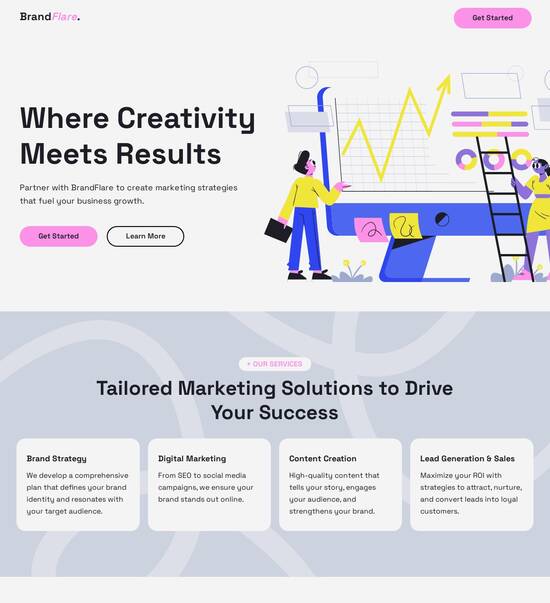
App page template with interactive privacy policy form
Explore Similar TemplatesAbout template
Use app page templates with interactive privacy policy form and make your communications easy and transparent. Try our solution today.
Recommended templates

Easy to build without coding
With the intuitive drag-and-drop builder, anyone on your team can create high-converting pages without any knowledge of code or design. Make enhancements to your landing page with custom widgets using Javascript, HTML/CSS, or third-party scripts.

Multiple layouts for any industry and goal
Select from 500+ landing page layouts built to boost conversions across industry-specific scenarios. Customize them by adjusting fonts, adding images, and generating on-brand content with the AI assistant. Quickly scale with Instablocks® and Global Blocks that you can save, reuse, and update globally.

Loads fast and looks polished on any device
Every template is responsive, which means they present professionally on any device and load blazingly fast with our Thor Render Engine. You can also power them up with Google AMP technology to deliver an unparalleled mobile experience and drive higher conversions.

Robust analytics & experimentation
Get real-time updates and reporting across all your devices, showing the number of visitors, conversions, cost-per-visitor, and cost-per-lead. Launch AI-powered experiments, run A/B tests, and use heatmaps to analyze user behavior, then optimize your landing page to maximize conversions.







Easy to build without coding
With the intuitive drag-and-drop builder, anyone on your team can create high-converting pages without any knowledge of code or design. Make enhancements to your landing page with custom widgets using Javascript, HTML/CSS, or third-party scripts.
Multiple layouts for any industry and goal
Select from 500+ landing page layouts built to boost conversions across industry-specific scenarios. Customize them by adjusting fonts, adding images, and generating on-brand content with the AI assistant. Quickly scale with Instablocks® and Global Blocks that you can save, reuse, and update globally.
Loads fast and looks polished on any device
Every template is responsive, which means they present professionally on any device and load blazingly fast with our Thor Render Engine.
Robust analytics & experimentation
Get real-time updates and reporting across all your devices, showing the number of visitors, conversions, cost-per-visitor, and cost-per-lead. Launch AI-powered experiments, run A/B tests, and use heatmaps to analyze user behavior, then optimize your landing page to maximize conversions.
All the features you need to build app privacy policy template
Explore more featuresLearn how to build sample privacy policy for mobile app
Frequently asked questions about mobile app privacy policy sample
Leading the way in building high-performing landing pages





Sample privacy policy for apps: Your ultimate how-to guide
Creating a compelling app page template is crucial for engaging users and maximizing conversions. Instapage's platform provides marketers with powerful tools to effortlessly build interactive privacy policy forms that enhance user experience and build trust. This guide will take you through each step of crafting an effective app page template.
Understanding the significance of an interactive privacy policy form
An interactive privacy policy form not only helps in compliance with legal regulations but also assures users that their data is handled responsibly. By leveraging Instapage’s customizable templates, you can create forms that clarify your app's data usage effectively.
- Ensures regulatory compliance: Interactivity helps users understand their rights and your responsibilities.
- Enhances user trust: Clearly presented information can increase user confidence in your application.
- Facilitates seamless user experience: Simplifying the policy form encourages users to engage without feeling overwhelmed.
Step 1: Selecting the right template
Start by exploring Instapage’s extensive library of over 100 high-converting templates. Choose a structure that aligns well with your app’s branding and the necessary functionality of the privacy policy form.
Step 2: Customizing the template
Once you've selected a template, it’s time to tailor it to your specific needs. Here’s how to do that:
- Update branding elements: Ensure that your logo and color scheme are applied for consistency.
- Incorporate interactive elements: Use tools like dynamic text replacement to personalize messages to your audience.
- Adjust layout: Utilize Instablocks to rearrange sections for improved visual flow.
Step 3: Integrating the privacy policy form
Next, embed your interactive privacy policy form within the template. This is crucial for clarity and usability.
- Use clear headings and subheadings: Break down the components of your policy for better comprehension.
- Add checkboxes for consent: Implement checkboxes that users must engage with before submitting information.
- Link to full policy documents: Provide quick access to detailed privacy policies for users seeking more information.
Following these steps, you will have an effective app page template that reinforces user trust through transparency.
Ready to transform your digital marketing campaigns? Start using Instapage today to create your customized app page template with an interactive privacy policy form.
People also ask about how to write a privacy policy for an app
App page template with interactive privacy policy form
Understanding the landscape: The role of interactive privacy policy forms in modern apps
As digital marketing continues to evolve, so do the data privacy concerns that accompany it. With increasing scrutiny on how businesses collect, store, and use personal information, consumers are more aware than ever of their rights. This heightened awareness is prompting organizations to adopt transparent practices in order to build and maintain trust with their users. Incorporating interactive privacy policy forms in app page templates is a strategic response to these demands.
Transparency is vital in fostering user engagement. When consumers have access to clear and comprehensible privacy policies, they are more likely to engage with a brand. This direct correlation between transparency and trust cannot be overlooked—trust influences everything from initial downloads to consistent usage of applications. With various privacy regulations in play globally, businesses must also navigate compliance while retaining user fidelity.
The implications are vast; legal repercussions can result from failing to adhere to privacy regulations, impacting a company's bottom line and reputation. Therefore, an interactive privacy policy form within an app page template not only serves a functional role but is also part of a broader strategy to ensure user-centric practices are in place.
Key features of an app page template with interactive privacy policy form
An effective app page template with an interactive privacy policy form should include various critical features to enhance user experience and ensure compliance. These features offer businesses a flexible way to address user concerns concerning data privacy.
Customizable design elements: Brands should have the freedom to customize design elements within the privacy policy form. This includes adjusting colors, fonts, and layouts to ensure consistency with their overall branding. Engaging layouts not only capture user attention but also ensure that critical information aligns visually with the app's theme.
Cookie consent templates: Cookie consent banners are vital for compliance with regulations. Variations in cookie consent options can be used to explain to users how cookies are utilized, providing them with choices and options that reinforce consent gathering. These templates must be designed to be straightforward, allowing users to make informed decisions.
Interactivity and user engagement: Incorporating dynamic elements can prompt visitors to interact with the policy. For instance, including expandable sections or clickable FAQs encourages users to ask questions and seek clarification, creating an engaging experience that can foster better comprehension.
Crafting compelling and informative privacy policies
Writing an effective privacy policy involves more than just legal compliance; it is a means of communicating a commitment to user privacy. Essential components of a privacy policy include details about what data is collected, how it is used, who it is shared with, and how it is protected. Businesses should strive to be transparent while regularly updating these documents to reflect current practices.
Additionally, the language used should be accessible to all users. Technical jargon can alienate users who may not be familiar with legal terms. Thus, using simple language helps clarify the message, making it easier for users to understand their rights regarding data handling.
Addressing common visitor concerns also plays a crucial role in user trust. By clearly explaining data handling practices and emphasizing safety measures, businesses can assure users that their personal information is treated with the utmost care.
Innovative functionalities of interactive forms
Interactive privacy policy forms can significantly elevate user experience through thoughtful design and navigational elements. A well-structured layout can guide users seamlessly through the approval process, enhancing their overall journey on the app. Key design options should include obvious buttons and pathways illustrating how to approve or disapprove consent without confusion.
Moreover, confirmation and feedback mechanisms play a role in enhancing user trust. Confirmation messages reassure users that their selections have been recognized. Companies can also utilize analytics tools to better understand user interactions; this data can inform potential improvements to the privacy policy form, ensuring it meets user expectations.
The ripple effect: How a robust privacy policy enhances trust and reputation
Building trust with visitors is just as crucial as acquiring them. When companies exhibit a strong commitment to privacy, customers are more likely to return. Strategies to communicate this dedication include creating detailed privacy resources and actively responding to user inquiries concerning data practices.
Case studies from businesses that have effectively communicated their privacy policy show that transparency correlates with business growth. Companies that prioritize clear privacy practices often see increased customer loyalty, as users feel more secure in their relationships with brands that respect their data.
The long-term benefits of transparency are evident through user loyalty that directly impacts brand reputation and conversion rates. Consumers are more inclined to convert to premium services or remain long-term customers when they trust that their personal data is secure and managed responsibly.
Compliance with privacy regulations: Adapting to ever-changing landscapes
Understanding global privacy standards is paramount for businesses to avoid penalties and maintain customer trust. Key regulations like GDPR and CCPA set stringent requirements regarding user data privacy. Any app designed for a global audience must comply with these laws to ensure operational integrity.
A compliance checklist can assist app developers and marketers in ensuring every aspect of their privacy policies is up to standard. Regular audits and updates are essential to reflect any changes in legislation.
Proactive measures are also vital for ongoing compliance. Leveraging technology to automate consent management and quickly adapt privacy policy content helps businesses remain ahead of regulatory changes, minimizing the risk of non-compliance.
Real-world applications: Successful implementations of interactive privacy policies
Examples from various industries showcase how businesses are utilizing interactive forms to enhance engagement and trust. Companies that prioritize clear privacy communications are often rewarded with improved customer relationships and higher conversion rates. By adopting innovative interactive forms, they empower users with choices about their data.
On the contrary, organizations that fail to prioritize privacy transparency often experience significant backlash. Learning from these cases reveals that the lack of proactive communication can erode trust and potentially damage a brand's reputation.
Vital metrics for assessing the impact of privacy policies include user engagement rates, bounce rates, and feedback volumes. Understanding these metrics allows for better optimization of privacy policy forms.
Effective staffing and resource allocation ensure that privacy policies are managed properly, allowing for immediate responses to user concerns and changes in legislation.
Visual storytelling: The future of privacy policy interaction on app pages
Graphics and visual cues play an essential role in conveying complex privacy policy information. Utilizing infographics can simplify dense texts, transforming legal jargon into clear visuals that encourage user comprehension. Creative design trends, such as minimalism or contrasting colors, can also enhance users' ability to retain important details.
Emerging technologies like artificial intelligence can personalize user interactions, tailoring experiences based on individual preferences. Furthermore, technologies such as augmented reality (AR) and virtual reality (VR) have the potential to revolutionize how users engage with privacy policies, creating immersive experiences that improve overall understanding.
The road ahead: Evolving user expectations in the era of privacy
As users become increasingly aware of their rights, businesses must anticipate their needs by evolving privacy policies beyond traditional texts. The future promises a more interactive approach, encouraging real-time communication and feedback regarding data handling practices.
Empowering users through education is paramount. By providing resources and tools that explain data privacy rights and fostering a community dialogue around privacy, businesses can strengthen relationships with their audience.
Ultimately, keeping pace with evolving privacy trends will require ongoing adaptation and innovative strategies, ensuring that user needs are consistently met and trust is maintained.
Ready to skyrocket conversions?
Supercharge your ad campaigns with high-performing landing pages
Get started














